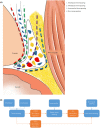NeuroSAFE in radical prostatectomy increases the rate of nerve-sparing surgery without affecting oncological outcome
- PMID: 35536200
- PMCID: PMC9796592
- DOI: 10.1111/bju.15771
NeuroSAFE in radical prostatectomy increases the rate of nerve-sparing surgery without affecting oncological outcome
Abstract
Objectives: To investigate the impact of intra-operative neurovascular structure-adjacent frozen-section examination (NeuroSAFE) on the rate of nerve-sparing surgery (NSS) and oncological outcome in a large radical prostatectomy (RP) cohort.
Patients and methods: Between January 2016 and December 2020, 1756 prostate cancer patients underwent robot-assisted RP, of whom 959 (55%) underwent this with NeuroSAFE and 797 (45%) without (control cohort). In cases where NeuroSAFE showed tumour in the margin, a secondary resection was performed. The effect of NeuroSAFE on NSS and positive surgical margin (PSM) status was analysed using logistic regression. Cox regression was used to identify predictors of biochemical recurrence-free survival (BCRFS).
Results and limitations: Patients in the NeuroSAFE cohort had a higher tumour grade (P < 0.001) and clinical stage (P < 0.001) than those in the control cohort. NeuroSAFE enabled more frequent NSS for both pT2 (93% vs 76%; P < 0.001) and pT3 disease (83% vs 55%; P < 0.001). In adjusted analysis, NeuroSAFE resulted in more frequent unilateral (odds ratio [OR] 3.90, 95% confidence interval (CI) 2.90-5.30; P < 0.001) and bilateral (OR 5.22, 95% CI 3.90-6.98; P < 0.001) NSS. While the PSM rate decreased from 51% to 42% in patients with pT3 stage disease (P = 0.031), NeuroSAFE was not an independent predictor of PSM status (OR 0.85, 95% CI 0.68-1.06; P = 0.2) in the entire cohort. Patients who underwent NeuroSAFE had better BCRFS compared to the control cohort (hazard ratio 0.62, 95% CI 0.45-0.84; P = 0.002). This study is limited by its comparison with a historical cohort and lack of functional outcomes.
Conclusions: NeuroSAFE enables more unilateral and bilateral NSS without negatively affecting surgical margin status and biochemical recurrence. This validation study provides a comprehensive overview of the implementation, evaluation and intra-operative decision making associated with NeuroSAFE in clinical practice.
Keywords: frozen-section analysis; nerve-sparing; neurosafe; prostate cancer; robot-assisted radical prostatectomy.
© 2022 The Authors. BJU International published by John Wiley & Sons Ltd on behalf of BJU International.
Figures


References
-
- Preisser F, Marchioni M, Nazzani S et al. Trend of adverse stage migration in patients treated with radical prostatectomy for localized prostate cancer. Eur Urol Oncol 2018; 1: 160–8 - PubMed
-
- Suardi N, Moschini M, Gallina A et al. Nerve‐sparing approach during radical prostatectomy is strongly associated with the rate of postoperative urinary continence recovery. BJU Int 2013; 111: 717–22 - PubMed
-
- Avulova S, Zhao Z, Lee D et al. The effect of nerve sparing status on sexual and urinary function: 3‐year results from the CEASAR study. J Urol 2018; 199: 1202–9 - PubMed
Publication types
MeSH terms
LinkOut - more resources
Full Text Sources
Medical
Miscellaneous

